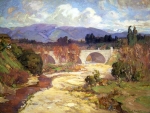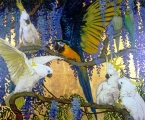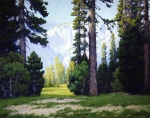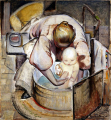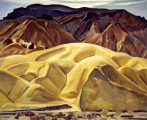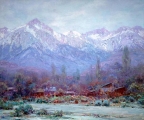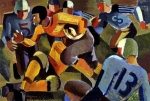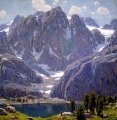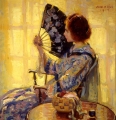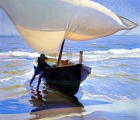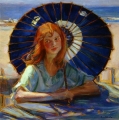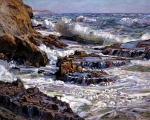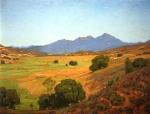In the early years of the 20th century, California produced a unique artistic style which combined several distinctive aspects of American and European art. This style, which is often called California Impressionism or California Plein Air painting, concerned itself with light and color. As a variant of the American Impressionist style, it focused directly on the abundant California light.
Landscape painting is a time-honored tradition that is inseparable from the spirit of American art. Indeed, from colonial times, American art has been governed by special circumstances unique to our country. Unlike Europe, American art was nurtured in the absence of empowered patronage, such as the monarchy or the church, both of which were powerful determinants in the progress of European art. Likewise, American artists retained a penchant for portraying genre, that is to say, the everyday character of American life. These “democratic” tendencies encouraged the espousal of landscape painting as the ideal vehicle for expressing the American spirit, as it created a metaphor of the American landscape as the fountainhead from which sprang the bounty and opportunity of rustic American life. Moreover, landscape painting afforded an avenue to express God and Nature as one, an understanding of spirituality that disavowed official religious patronage. When America emerged in the 19th century, it was with an art tradition that reflected what was paramount to American society — its people and its land. These “democratic” tendencies encouraged the espousal of landscape painting as the ideal vehicle for expressing the American spirit, as it created a metaphor of the American landscape as the fountainhead from which sprang the bounty and opportunity of rustic American life. Moreover, landscape painting afforded an avenue to express God and Nature as one, an understanding of spirituality that disavowed official religious patronage. When America emerged in the 19th century, it was with an art tradition that reflected what was paramount to American society — its people and its land.
In the early years of the 20th century, California produced a unique artistic style which combined several distinctive aspects of American and European art. This style, which is often called California Impressionism or California Plein Air painting, concerned itself with light and color. As a variant of the American Impressionist style, it focused directly on the abundant California light. Here, the land became the principal subject of this style, and it was represented as clean and unspoiled, with vigor and grandeur. The sun shone its light on the land and gave it color: greens of spring, browns of late summer and fall and everywhere, the deep blue mantle of the sky.
In California, landscape painting was by far the most popular subject among its myriad painters. Where the French Impressionists yearned to capture the immediate moment, or the temporal fragment of societal activity, California’s Impressionists sought to catch the fleeting moment of specific natural light as it bathed the landscape. The clear and intense light of California, which appears so often in these paintings, defined the landscape. The biblical analogy of light as the creative instrument is appropriate to the California landscape and the way artists addressed it; for without that unique light and the divine energy it represented, the land would not exist.
Thus, the goal was to capture this striking visual sensation on canvas quickly, before the light changed. The key to achieving this goal was to get out of the studio and to paint outdoors, en plein air, and to accentuate the role of color to produce brilliant light effects.
California Impressionism: Selections from The Irvine Museum opens May 3 and runs through September 6, 2015 at Gilcrease Museum. Some of the most popular works of art in The Irvine Museum’s collection will be displayed in this exhibition.
